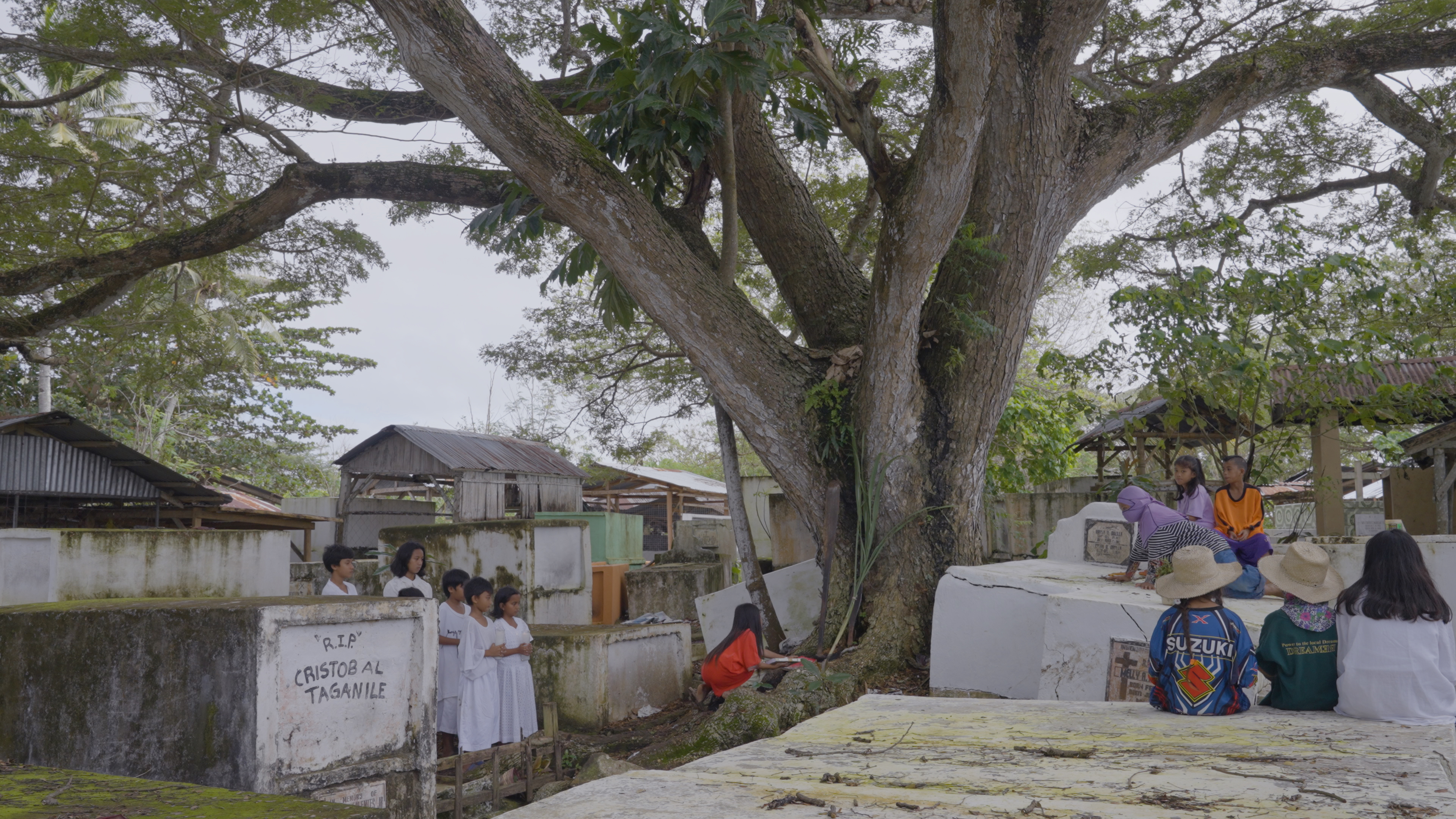


Enzo Camacho & Ami Lien, Langit Lupa, 2023, still from digital video. Courtesy of the artists
Glasgow International, 10th edition
Friday 7th – Sunday 23rd June 2024
The latest Glasgow International festival opened last Friday 7th June and runs until 23rd June. Richard Birkett is the curator of this edition, which spreads generously across the whole city through collaborations with the major institutions as well as smaller, independent and artist-run spaces. Heavy on moving image and with an important performance programme as well, there is a wealth of new work to see this month. Below are a few highlights from my visit.
Amy Lien and Enzo Camacho’s major installation in the ground floor gallery at GOMA is titled Offerings for Escalante. The central element, an hour-long, single channel narrative film, is complemented by a small scale 16mm projection and a series of collages around the walls. The work focusses on a notorious incident on the island of Negros in the Philippines. Under the Marcos regime in 1985, more than two hundred plantation workers were massacred while peacefully protesting for higher wages. The tale unfolds through various first-person testimonies which bring an emotional charge and texture through small details: the language has two different words for hunger: the first is that ordinary sensation experienced when looking forward to a meal; the second is the type of hunger more akin to starvation. The Island of Negros was widely deforested in order to plant the cash crop ‘sugar beet’. In the three or four months when there is no sugar beet to harvest or plant, the plantation workers have no work and no income. The film braids together issues surrounding ecological violence, land justice and workers rights, while operating as an act of remembrance for those individuals, some very young, who lost their lives to violent repression.
Though it is not on the GI programme, special mention should be made for the exhibition of work by Sam Ainsley on the first floor at GOMA. Renowned for the influence of her teaching at the Glasgow School of Art through the 1980s and 90s, fostering a generation of artists who have gone on to glittering international careers, her own work is much less widely known. With the synaesthetic title Wednesday is Cobalt blue, Friday is Cadmium red, her current show majors on shaped and collaged painted canvases. With motifs drawn from the natural world as well as self-portraits with her instantly recognisable bobbed hair, the work is joyous, and Ainsley was definitely one of the discoveries on the trip.
Over at Tramway, Turner Prize nominee Delaine Le Bas is presenting an exuberant and immersive installation that brings together painted textiles, figurative sculptures and texts. With an aesthetic based in calico and straw bales, Delainia:17071965 Unfolding is the artist’s alternative mythology for the Romani people. She re-imagines the mysterious Minoan snake goddess of Greece as a giantess crowned with a coronet emblazoned ‘Untamed’; Medusa appears in one of the textile paintings, lactating glitter. In one enclosed space reminiscent of a circus tent, a series of rag dolls are suspended, their bodies exquisitely embroidered and sequinned in a way that recalls the tattooed ladies of Victorian circuses. Le Bas protests the routine discrimination experienced by Romani people across centuries and through her work carves out a space for their history and culture.
Another discovery of the trip was at 42 Carlton Place, where Merlin James has staged a show of paintings by the late American artist, David Byrd. Born in 1926, after serving in the Second World War and thanks once again to the GI Bill, he studied art first in Philadelphia and then in New York at the Ozenfant School of Fine Arts. Unable to make a breakthrough with his painting, he spent thirty years working as an orderly in a veterans psychiatric hospital in the Catskills. All the while however, Byrd continued to paint and the hospital featured in many of his canvasses. Here in Glasgow, however, we see works influenced by another of his regular pass times: attending auctions. In the enigmatic Scroll Flask and Hand, 1989, a dapper auctioneer stands at his podium, ostensibly locking eyes with a bidder for the luminous flask on a plinth to his right. He looks a little worried. There is a hand reaching towards the flask from out of the frame of the picture, as if to steal it. Glimpsed through a gap in the background panels, a woman stands in profile, one hand clutched to her stomach as if in discomfort. The scene crackles with tension. Another woman looks out at the viewer. We assume she is seated since all we can see is her head turned towards us. She is rendered in a completely different style from the other figures, almost cartoonish, her face lit up with a blueish light. Sketchbook drawings here are reminiscent of Daumier’s courtroom sketches, full of character, gesture and dynamism.
At the Modern Institute’s Aird’s Lane main space, Richard Wright has made a monumental new wall painting. At a guess it is fifteen feet high and twenty-five feet wide. Perhaps the most optically challenging work of his that I have seen, it plays with chequerboard patterning, switching scales and orientations in a way that keeps the eye rattling around the composition, acutely conscious of the act of focussing. The central panel, roughly but not strictly symmetrical, uses red, pink, emerald green and royal blue, while the outer sections are black and white. The effect of the changing scale of the pattern creates a strong sensation of motion, of pulsating energy. The artist has spoken of the ‘delirium of vision’ and the phrase could not be more apt for the ecstatic experience of looking at this work. It will be on show until 5 September after which it will be painted over to make way for the next exhibition.
Caroline Douglas, Director